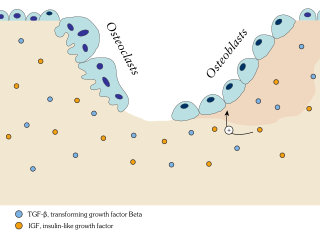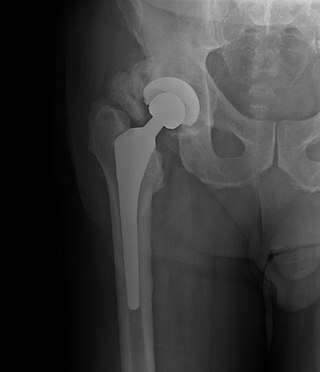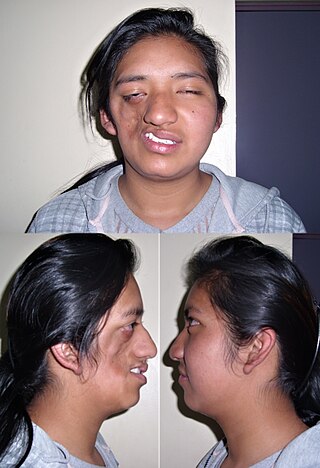Related Research Articles

Panniculitis is a group of diseases whose hallmark is inflammation of subcutaneous adipose tissue. Symptoms include tender skin nodules, and systemic signs such as weight loss and fatigue.

Ankylosis is a stiffness of a joint due to abnormal adhesion and rigidity of the bones of the joint, which may be the result of injury or disease. The rigidity may be complete or partial and may be due to inflammation of the tendinous or muscular structures outside the joint or of the tissues of the joint itself.

Ossification in bone remodeling is the process of laying down new bone material by cells named osteoblasts. It is synonymous with bone tissue formation. There are two processes resulting in the formation of normal, healthy bone tissue: Intramembranous ossification is the direct laying down of bone into the primitive connective tissue (mesenchyme), while endochondral ossification involves cartilage as a precursor.

Fibrodysplasia ossificans progressiva, also called Münchmeyer disease or formerly myositis ossificans progressiva, is an extremely rare connective tissue disease in which fibrous connective tissue such as muscle, tendons, and ligaments turn into bone tissue (ossification). It is the only known medical condition where one organ system changes into another. It is a severe, disabling disorder with no cure.
Connective tissue disease, also known as connective tissue disorder, or collagen vascular diseases, refers to any disorder that affect the connective tissue. The body's structures are held together by connective tissues, consisting of two distinct proteins: elastin and collagen. Tendons, ligaments, skin, cartilage, bone, and blood vessels are all made of collagen. Skin and ligaments contain elastin. The proteins and the body's surrounding tissues may suffer damage when these connective tissues become inflamed.

Myositis ossificans comprises two syndromes characterized by heterotopic ossification (calcification) of muscle. The World Health Organization, 2020, has grouped myositis ossificans together with fibro-osseous pseudotumor of digits as a single specific entity in the category of fibroblastic and myofibroblastic tumors.

Heterotopic ossification (HO) is the process by which bone tissue forms outside of the skeleton in muscles and soft tissue.

Activin A receptor, type I (ACVR1) is a protein which in humans is encoded by the ACVR1 gene; also known as ALK-2. ACVR1 has been linked to the 2q23-24 region of the genome. This protein is important in the bone morphogenic protein (BMP) pathway which is responsible for the development and repair of the skeletal system. While knock-out models with this gene are in progress, the ACVR1 gene has been connected to fibrodysplasia ossificans progressiva, an extremely rare progressive genetic disease characterized by heterotopic ossification of muscles, tendons and ligaments. It is a bone morphogenetic protein receptor, type 1.

Parry–Romberg syndrome (PRS) is a rare disease presenting in early childhood characterized by progressive shrinkage and degeneration of the tissues beneath the skin, usually on only one side of the face but occasionally extending to other parts of the body. An autoimmune mechanism is suspected, and the syndrome may be a variant of localized scleroderma, but the precise cause and pathogenesis of this acquired disorder remains unknown. It has been reported in the literature as a possible consequence of sympathectomy. The syndrome has a higher prevalence in females and typically appears between 5 and 15 years of age. There has been only one case report of the syndrome appearing in older adults: a 43-year-old woman with symptoms appearing at the age of 33.
Bone disease refers to the medical conditions which affect the bone.

Ectopic calcification is a pathologic deposition of calcium salts in tissues or bone growth in soft tissues. This can be a symptom of hyperphosphatemia. Formation of osseous tissue in soft tissues such as the lungs, eyes, arteries, or other organs is known as ectopic calcification, dystrophic calcification, or ectopic ossification.
Cutaneous meningioma, also known as heterotopic meningeal tissue, and rudimentary meningocele is a developmental defect, and results from the presence of meningocytes outside the calvarium.

Harry Raymond Eastlack, Jr. was the subject of the most recognized case of fibrodysplasia ossificans progressiva (FOP) from the 20th century. His case is also particularly acknowledged, by scientists and researchers, for his contribution to medical advancement. After living with a rare, disabling, and currently incurable genetic disease, Eastlack decided to have his skeleton and medical history donated to the Mütter Museum of the College of Physicians of Philadelphia in support of FOP research. His skeleton is one of the few FOP-presenting, fully articulated ones in existence, and it has proved valuable to the study of the disease.

Osteoma cutis is a cutaneous condition characterized by the presence of bone within the skin in the absence of a preexisting or associated lesion. Osteoma cutis often manifests as solid, varying-sized, skin-colored subcutaneous nodules.
The International Fibrodysplasia Ossificans Progressiva Association (IFOPA) is a US-based 501(c)(3) non-profit organization supporting medical research, education and communication for those afflicted by the rare genetic condition Fibrodysplasia Ossificans Progressiva (FOP). IFOPA's mission is to fund research to find a cure for FOP while supporting, connecting, and advocating for individuals with FOP and their families, and raising awareness worldwide. IFOPA is governed by a volunteer board of directors which may range in number from 9 to 15, at least one of whom must have FOP. The association's location is 1520 Clay St., Suite H2, North Kansas City, MO, 64116, part of the Kansas City, Missouri metropolitan area.

Palovarotene, sold under the brand name Sohonos, is a medication used for the treatment of heterotopic ossification and fibrodysplasia ossificans progressiva. It is a highly selective retinoic acid receptor gamma (RARγ) agonist. It is taken by mouth.

FOP Friends, formerly Friends of Oliver, is a registered charity in the United Kingdom established on 1 March 2012. It aims to raise funds that are needed to find effective treatments for the rare genetic condition fibrodysplasia ossificans progressiva (FOP). The charity also works to raise awareness and understanding of FOP amongst medical communities and the general public.

Frederick S. Kaplan is an American medical doctor specializing in research of musculoskeletal disorders such as fibrodysplasia ossificans progressiva (FOP).

Eileen M. Shore is an American medical researcher and geneticist specializing in research of muscoskeletal disorders such as fibrodysplasia ossificans progressiva.
Carol Orzel was an American woman with fibrodysplasia ossificans progressiva (FOP). She advocated for research into FOP and was an activist for disability rights. Before her death, she requested that her skeleton be displayed in the Mütter Museum.
References
- ↑ Rapini, Ronald P.; Bolognia, Jean L.; Jorizzo, Joseph L. (2007). Dermatology: 2-Volume Set. St. Louis: Mosby. ISBN 978-1-4160-2999-1.
- ↑ "About POH Disease" . Retrieved 2012-06-15.
- ↑ Adegbite NS, Xu M, Kaplan FS, Shore EM, Pignolo RJ (July 2008). "Diagnostic and mutational spectrum of progressive osseous heteroplasia (POH) and other forms of GNAS-based heterotopic ossification". Am. J. Med. Genet. A. 146A (14): 1788–96. doi:10.1002/ajmg.a.32346. PMC 2564798 . PMID 18553568.
- ↑ Karen Kreeger (October 9, 2017). "Piecing Together the Puzzle of a Rare-Among-Rare Bone Disorder". University of Pennsylvania Health System.
- ↑ Kaplan, F. S.; Craver, R.; MacEwen, G. D.; Gannon, F. H.; Finkel, G.; Hahn, G.; Tabas, J.; Gardner, R. J.; Zasloff, M. A. (1994). "Progressive osseous heteroplasia: a distinct developmental disorder of heterotopic ossification. Two new case reports and follow-up of three previously reported cases". Journal of Bone and Joint Surgery. 76 (3): 425–436. doi:10.2106/00004623-199403000-00013. PMID 8126048.
- ↑ Kaplan, Frederick S.; Shore, Eileen M. (2000). "Progressive Osseous Heteroplasia". Journal of Bone and Mineral Research. 15 (11): 2084–2094. doi: 10.1359/jbmr.2000.15.11.2084 . PMID 11092391. S2CID 21642426.